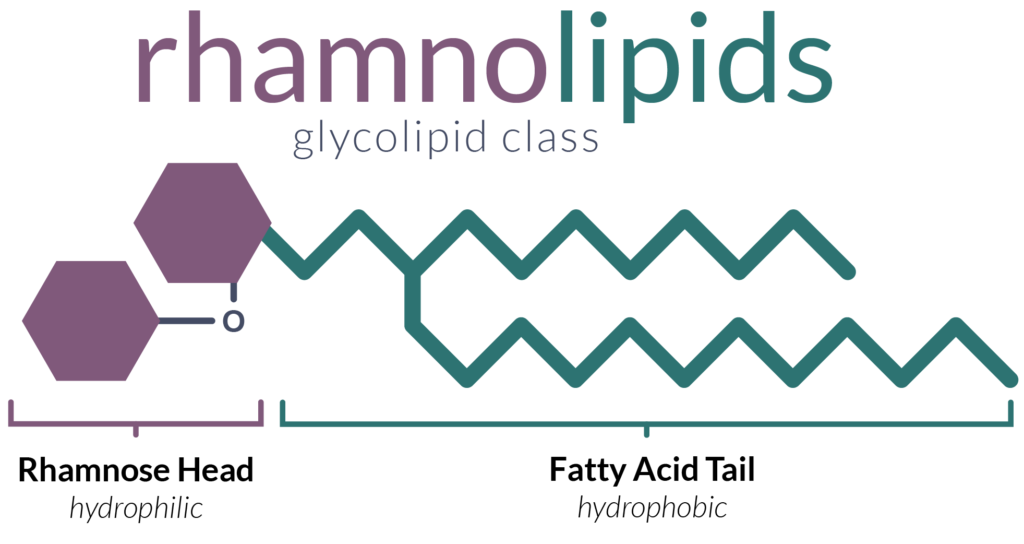Biosurfactants – surfactants derived from biological organisms – are increasingly gaining attention as awareness and demand grows for more green chemicals and products. There are many classes of biosurfactants, which vary in their molecular structure and chemical properties. Previously we explored sophorolipids, a subset of the glycolipid class of biosurfactants. This time, we’ll look at another class of glycolipids: rhamnolipids.
Derived and produced most frequently by the bacteria Pseudomonas aeruginosa, rhamnolipids are a type of low molecular weight (LMW) biosurfactant and are a subset of the glycolipid family. They are one of the most widely studied glycolipids. As the name suggests, rhamnolipids have two distinct parts: a rhamnose-based head and a fatty acid (lipid) tail.

Rhamnose is a type of sugar molecule that hydrophilic (attracts water), while the lipid tail is hydrophobic (repels water) and is comprised of one or more saturated/unsaturated β-hydroxy fatty acids chains. Like other classes of biosurfactants, rhamnolipids are not homogeneous. Rather they can vary in their chemical structure in a variety of ways:
- Monomer or dimer in rhamnose head: The rhamnolipid “head” consists of either one rhamnose molecule, or two rhamnose molecules linked together (mono-rhamnolipids or di-rhamnolipids respectively).
- Size and structure of fatty-acid tail: The fatty-acid “tail” of rhamnolipids vary in their length and branching structure. It typically consists of one or two fatty acid chains bonded together, with varying number of carbon atoms making up each chain.
Properties & Advantages
Similar to other biosurfactants, rhamnolipids effectively lower surface tension, exhibit low-toxicity, have a strong wetting ability, and promote the biodegradation of poorly soluble substrates (e.g., emulsification of oil). However, despite the significant body of rhampnolipid research, the exact reason Pseudomonas aeruginosa produces rhamnolipids are still not entirely known to many researchers and is the subject of much speculation.
Interestingly, rhamnolipids play multiple roles for the producing organism in nature. For example, rhamnolipids exhibit antimicrobial properties that benefit Pseudomonas aeruginosa by providing a natural advantage against other microorganisms during niche colonization. Early studies of rhamnolipids demonstrated anti-microbial activity against a large variety of bacteria and fungi such as Bacillus subtilis, Serratia marcescens, and Chaetomium globosum.
Industry & Commercial Applications
Rhamnolipids have applications across many industries, including bioremediation, cosmetics, agriculture, food processing, and pharmaceuticals due to their efficient surface and biological capabilities.
A few examples:
- Bioremediation: Rhamnolipids are capable of efficiently down up oil from oil spills in water or soil, acting as biodegradable dispersants.
- Enhanced Oil Recovery: Rhamnolipids could replace chemical surfactants in traditional chemical EOR, which are routinely used in the extraction of crude oil.
- Agriculture: Rhamnolipids can act as a bio-pesticide against agricultural pests and can be used as an emulsifier and dispersing agent in pesticide formulations.
- Food Processing: Rhamnolipids serve as an antimicrobial agent, capable of cleaning food products and reducing food spoilage. They have the capacity to limit the growth of foodborne bacteria, such as B. subtilis and L. monocytogenes.
- Pharmaceuticals: Rhamnolipids can be used to produce nanoparticles for drug delivery, and recent in vitro studies suggest they can inhibit the growth of many human cancer cell lines, making it a potential anticancer agent.
Rhamnolipids are no doubt a rising and promising green biosurfactant in a broad range of industries. If produced economically and at scale, they can be an important part of the shift away from petroleum and palm-oil derived synthetic surfactants and towards greener and more sustainable products and processes.
References & Further Reading
- Thakur P, Saini NK, Thakur VK, Gupta VK, Saini RV, Saini AK. Rhamnolipid the Glycolipid Biosurfactant: Emerging trends and promising strategies in the field of biotechnology and biomedicine. Microbial Cell Factories. 2021 Dec;20(1):1-5. https://doi.org/10.1186/s12934-020-01497-9
- Chong H, Li Q. Microbial production of rhamnolipids: opportunities, challenges and strategies. Microbial cell factories. 2017 Dec;16(1):1-2. https://doi.org/10.1186/s12934-017-0753-2
- Abdel-Mawgoud AM, Lépine F, Déziel E. Rhamnolipids: diversity of structures, microbial origins and roles. Applied microbiology and biotechnology. 2010 May;86(5):1323-36. https://doi.org/10.1007/s00253-010-2498-2
- Bhattacharya B, Ghosh TK, Das N. Application of bio-surfactants in cosmetics and pharmaceutical industry. Scholars Academic Journal Pharmacy. 2017;6(7):320-9. https://doi.org/10.21276/sajp